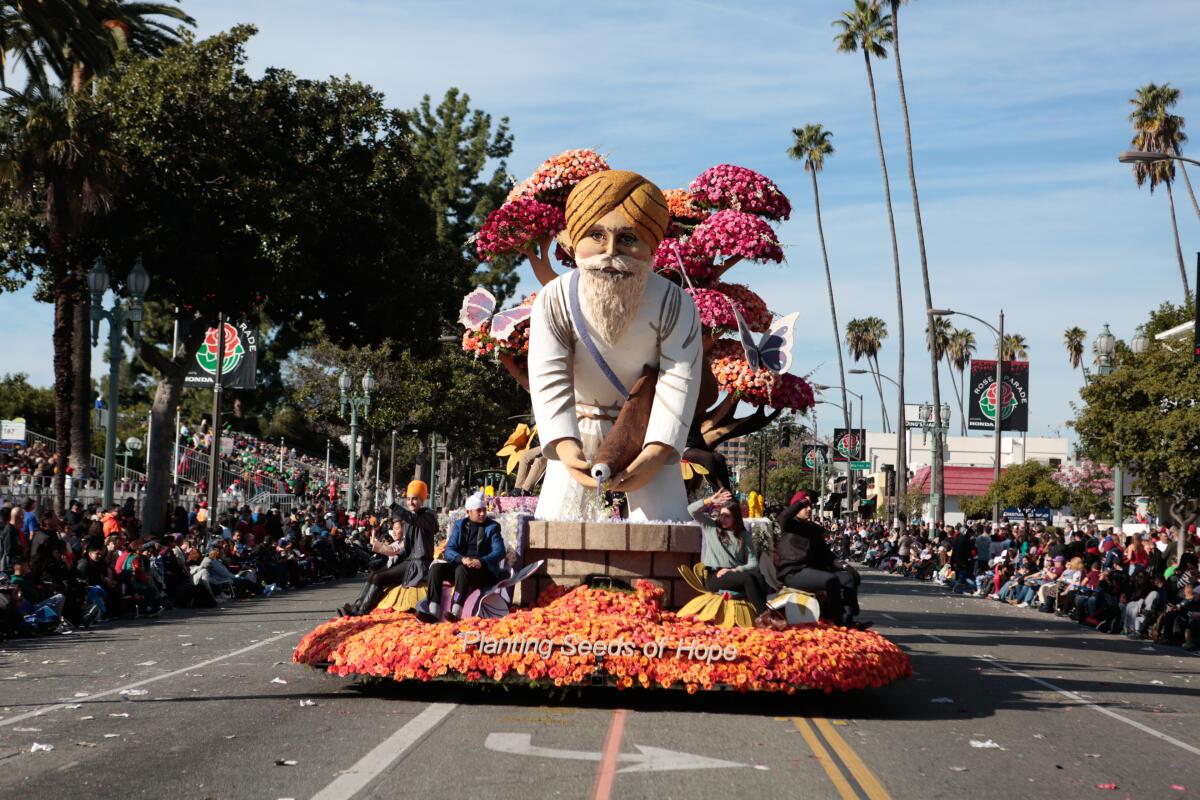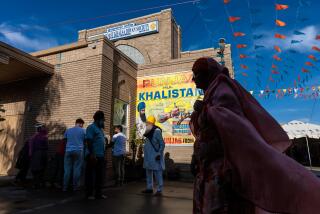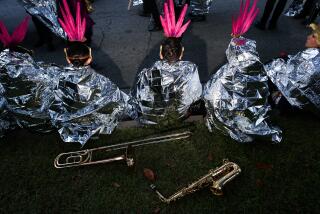Rose Parade 2020: Sikhs roll out a float to sow seeds of hope, generosity and harmony

Local Sikhs see the annual Rose Parade as an educational opportunity. For the sixth year, they created a dazzling float to highlight their faith and to promote ideas of “freedom, equality, compassion and service.”
Miles Lhotka has performed in at least four musicals and knows how to capture attention with dramatic movements. But this was the 12-year old’s first time on a float at the Rose Parade, and it was a much different beast.
To begin with, Lhotka had to sit for over two hours on a slowly moving object, waving at people more interested in the design of the float than the people atop it. To get their attention, he needed to wave. But “you can’t just move your wrist. You have to move your entire arm,” the La Cañada resident said. “Waving normally is not going to cut it.”
The young performer attempted to exude confidence as he rode down Colorado Boulevard, shouting “Happy New Year” to attendees recording him on their smartphones. Still, he was nervous. Perhaps what helped quell his nerves was knowing he’s part of something bigger.
For the sixth year in a row, the Sikh American Float Foundation motored a float down the 5½-mile parade route. This year, coffee grounds, lentils, walnuts, cranberries, spices and coconut flakes adorned the 85-foot-long float, titled “Planting Seeds of Hope.”
Maninder Minu Singh, creative director of the foundation, began thinking about the float’s design a year ago. She had to think of a way to connect this year’s parade theme, “The Power of Hope,” with the Sikh faith. Eventually, Singh settled on a large sculpting of Bhai Ghaneya Singh Ji, a Sikh from the 18th century known for giving water to wounded soldiers on the battlefield regardless of faith.
With the Irwindale-based Phoenix Decorating Co., Singh and 1,400 volunteers were able to bring to life a man who exemplified what the world should be, she said, “putting humanity above affiliations and differences.”
The float shows Ji pouring water, surrounded by 69,000 live roses and 16 real-life children. The presence of children from different backgrounds was important to showcase, Singh said, because they are the future of the world.
“If we plant seeds of love, compassion and service into young minds today, then they can design a world in the future that is more peaceful, kind, loving and beautiful,” she said.
An estimated 500,000 Sikhs live in the United States. The religion has roots in the 15th century Punjab region of India.
Some people wrongly assume that Sikhs are Muslims because of the turbans they wear. Violence against American Sikhs intensified after 9/11, when Islamophobia was on the rise.
In 2012, six people died in a mass shooting at a Sikh temple in suburban Milwaukee.
Recently, reports of hate crimes against the group have increased. In 2015, the FBI recorded six reports of hate crimes against Sikhs. In 2018 there were 60, a 200% increase from the 20 reported in 2017, according to figures provided by Brian Levin, director of the Center for the Study of Hate & Extremism at Cal State San Bernardino.
“Sikhs are attacked not only because they are confused with Muslims, but also because their adherents are doubly stereotyped” as part of a “foreign” faith, Levin said in an interview. He noted that changes in law enforcement data collection and the “excellent outreach made by the Sikh community” contributed in part to the dramatic increase in reports.
Local Sikhs see the parade as an educational opportunity. Having a float that showcases diversity and works with non-Sikhs, like Lhotka, is key to spreading a message of kindness and compassion, Singh said.
“At the end of the day, we all believe in freedom, equality, compassion and service,” she said. “Those are the things necessary to blur the lines of division and bring us together.”
“We represent not just the Sikh community but every minority who contributes to the great nation and deserves to be respected and celebrated,” she added.
Lhotka, who is nonreligious and white, said the message of compassion is important to him because it “promotes the idea of accepting difference to create equality.”
“The human race needs to realize it’s the human race,” the 12-year-old said. “This is a theme that needs to be more prominent today.”
More to Read
Start your day right
Sign up for Essential California for news, features and recommendations from the L.A. Times and beyond in your inbox six days a week.
You may occasionally receive promotional content from the Los Angeles Times.







